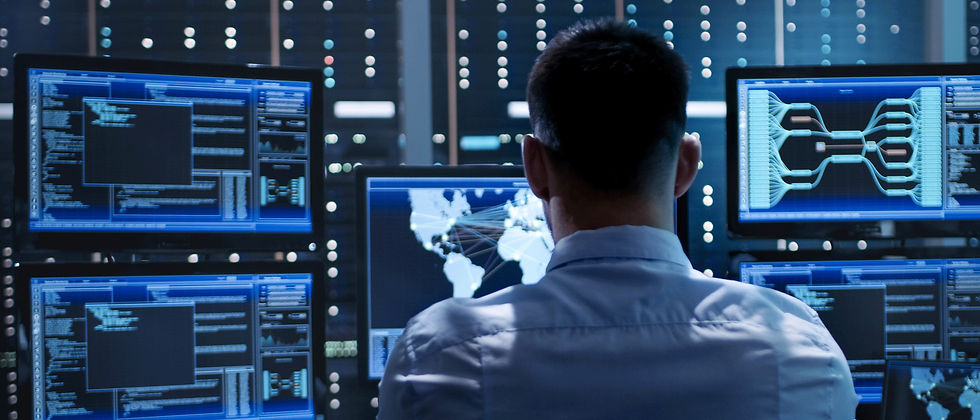Protecting Your Business Data: Cybersecurity Best Practices for CCTV Systems
- Marcela John
- 1 day ago
- 3 min read
Cyber Security for CCTV Systems
In today’s digital-first environment, cybersecurity is a critical component of every business operation. Surveillance networks, once considered standalone physical systems, are now interconnected with business IT infrastructures. This shift has made CCTV systems more powerful but also more vulnerable to cyber-attacks.
Organizations relying on CCTV monitoring services, remote CCTV services, or virtual doorman services must safeguard both their physical premises and the digital data behind them. A single weak point in the system can expose sensitive footage, operational data, and even customer information to cyber criminals.
This article outlines best practices for securing CCTV systems, while also highlighting how GCCTVMS enhances resilience through tailored monitoring and cyber protection.
The Growing Connection Between CCTV and Cyber Security
CCTV systems today are no longer just cameras and recording devices. They are integrated platforms involving cloud storage, remote access, two-way audio, and video analytics. This connectivity creates opportunities but also opens multiple entry points for attackers.
According to Cybersecurity for Video Surveillance Systems, unprotected surveillance systems are common targets for hackers seeking to:
Manipulate live footage.
Access customer or employee data.
Disrupt business operations.
Steal intellectual property.
Businesses across industries — from retail and healthcare to logistics and residential management — must now treat their surveillance systems as part of their larger cyber security ecosystem.
Why Cyber Security is Vital for CCTV Monitoring
Protecting Sensitive Footage
Captured video can include employees, customers, and business assets. Unauthorized access could put privacy, reputation, and compliance at risk.
Safeguarding Business Operations
Remote monitoring and 24/7 live CCTV monitoring services ensure constant surveillance. But without proper security, attackers could disable systems and leave businesses exposed.
Meeting Compliance Standards
Industries such as healthcare, finance, and construction face strict regulatory requirements. Securing footage and access controls is necessary for legal compliance. More insights are available in Cybersecurity in Healthcare Surveillance.
Best Practices for Cyber-Secure CCTV Systems
Strengthen Network Security
Use firewalls and intrusion detection systems.
Configure CCTV devices to operate on private, secure networks.
Implement VPN access for remote staff.
For more guidance, review Network Security for CCTV Systems.
Keep Firmware and Software Updated
Hackers often exploit outdated firmware in cameras and recorders. Regular updates prevent vulnerabilities from being misused. Businesses using remote CCTV services should ensure their providers actively manage updates across all devices.
Enforce Strong Authentication
Implement multi-factor authentication.
Require strong, unique passwords for all system users.
Restrict access based on roles to prevent unnecessary exposure.
This is especially important for virtual doorman services and nanny cams, where unauthorized access can compromise safety at residential and commercial sites.
Encrypt Data and Footage
Storing video data without encryption creates unnecessary risks. Data encryption for surveillance footage ensures that even if files are intercepted, they cannot be viewed or manipulated by attackers.
Monitor and Report Incidents Promptly
Combining cyber protection with detailed incident report practices enables faster response times. Automated alerts and detailed logs help organizations detect suspicious activities before damage occurs.
Cyber Security Applications Across Industries
Healthcare Facilities
Hospitals and clinics rely on surveillance for patient safety and regulatory compliance. Cyber-secured CCTV ensures privacy while preventing unauthorized access to sensitive environments.
Retail and Hospitality
Two-way audio integrated with CCTV protects customers and staff. Proper cybersecurity prevents criminals from hijacking live feeds.
Warehouses and Construction Sites
Remote monitoring prevents theft and trespassing. Cyber-hardening measures protect video integrity, ensuring footage cannot be tampered with.
Residential and Multi-Tenant Buildings
Virtual doorman services and nanny cams depend on safe access controls. Strong authentication prevents intruders from exploiting these services.
For broader insights, see Industrial Security Cyber Threats and Remote Video Monitoring Security Guidelines.
How GCCTVMS Strengthens Cyber Security for Surveillance
At GCCTVMS, our CCTV monitoring services are designed with cyber protection at their core. We combine real-time monitoring with advanced network defenses to ensure both physical and digital assets remain secure.

Comprehensive Monitoring
Our 24/7 live CCTV monitoring services provide constant oversight backed by encrypted data channels. This ensures surveillance feeds remain secure against tampering.
Layered Security Measures
We integrate video verification, two-way audio, and detailed incident documentation into every monitoring plan. This layered approach reduces both physical and cyber risks.
Industry-Specific Solutions
From hospitals and retail stores to warehouses and residential complexes, GCCTVMS offers tailored services that prioritize data security while enhancing safety.
Conclusion
As businesses continue to adopt connected surveillance, cybersecurity becomes an inseparable part of security management. Whether through remote CCTV services, virtual doorman services, or nanny cams, safeguarding video data ensures operational continuity and customer trust.
By enforcing strong network protections, encryption, regular updates, and structured incident reporting, businesses can minimize risks and maximize value from their CCTV investments.
For further insights, explore Best Practices for CCTV System Security and Cloud Security for Video Surveillance.



Comentarios